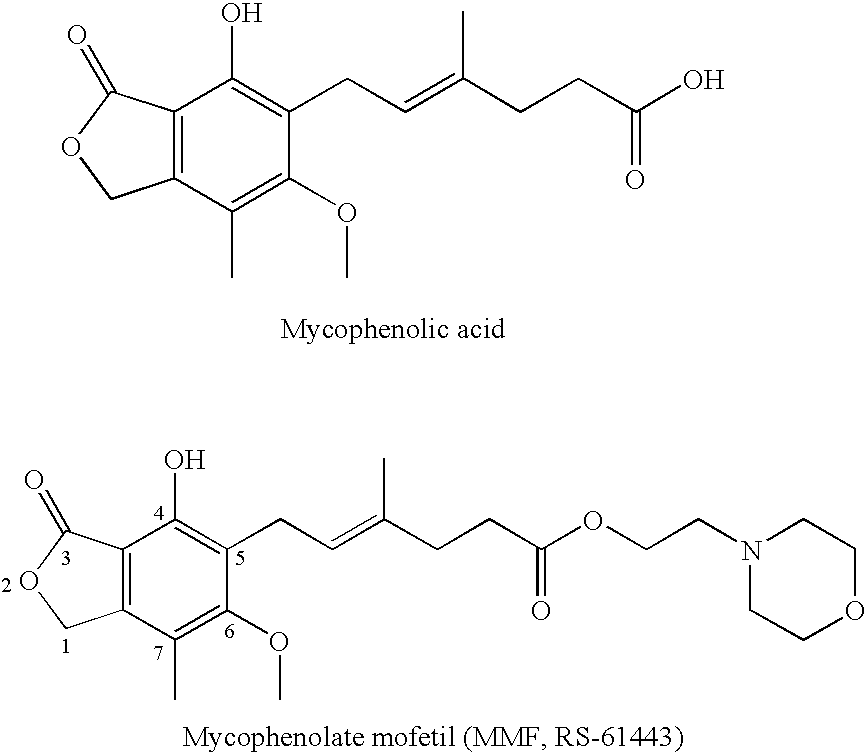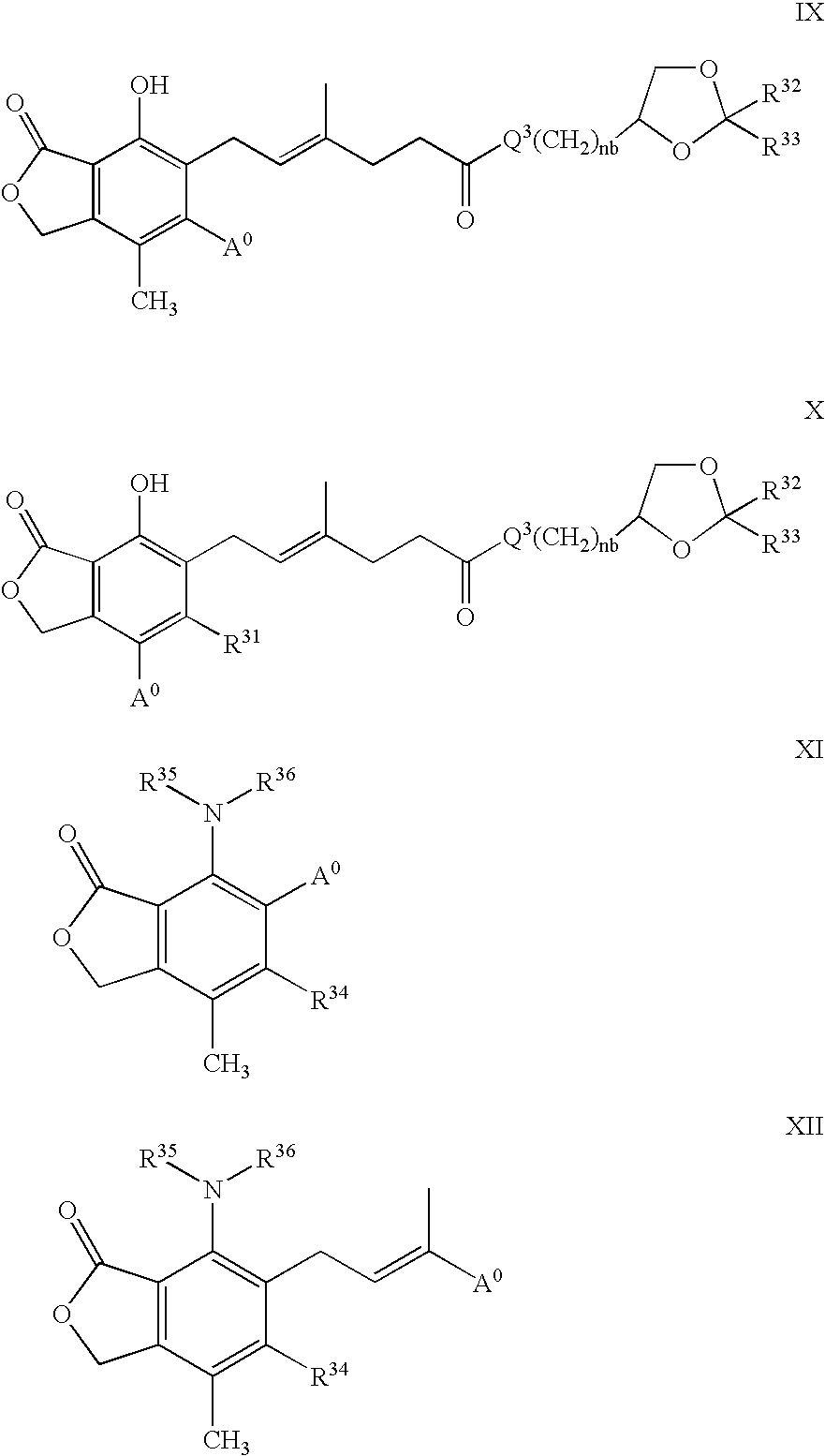Phosphonate Derivatives of Mycophenolic Acid
a technology of phosphonate and mycophenolic acid, which is applied in the field of phosphonate derivatives of mycophenolic acid, can solve the problems of difficult or inefficient drug redistribution, difficult intracellular target, and many attempts to develop effective methods, etc., to improve anti-cancer, anti-viral, and anti-inflammatory effects, and improve oral bioavailability.
- Summary
- Abstract
- Description
- Claims
- Application Information
AI Technical Summary
Benefits of technology
Problems solved by technology
Method used
Image
Examples
example 1
[0736]
{4-[6-Ethyl-7-methyl-3-oxo-4-(2-trimethylsilanyl-ethoxy)-1,3-dihydro-isobenzofuran-5-yl]-2-methyl-but-2-enyl}-phosphonic acid propan-2-one oxime ester anhydride: A solution of {4-[6-ethyl-7-methyl-3-oxo-4-(2-trimethylsilanyl-ethoxy)-1,3-dihydro-isobenzofuran-5-yl]-2-methyl-but-2-enyl}-phosphonic acid (450 mg, 1.02 mmol), acetone oxime (150 mg, 2.04 mmol) and DCC (850 mg, 4.08 mmol) in pyridine (3 mL) was stirred at 70° C. for 1.5 hr. The reaction was quenched by adding water (4 mL). The mixture was stirred at room temperature for 30 min. and concentrated. The residue was partitioned between CH2Cl2 and diluted aqueous HCl. The organic layer was concentrated and purified by RP HPLC, affording the desired product (396 mg, 57%). MS (m / z) 995 [M+Na]+.
2-(S)-{[4-(6-Ethyl-4-hydroxy-7-methyl-3-oxo-1,3-dihydro-isobenzofuran-5-yl)-2-methyl-but-2-enyl]-(isopropylideneamino-N-oxy)-phosphinoylamino}-propionic acid ethyl ester: this product was prepared using methods similar to those describ...
example 2
[0737]
2-{[4-(4-Hydroxy-6-ethyl-7-methyl-3-oxo-1,3-dihydro-isobenzofuran-5-yl)-2-methyl-but-2-enyl]-(isopropylideneamino-N-oxy)-phosphinoylamino}-propionic acid 3-morpholin-4-yl-propyl ester: DCC (112 mg, 0.52 mmol) was added to a solution of {4-[6-Ethyl-7-methyl-3-oxo-4-(2-trimethylsilanyl-ethoxy)-1,3-dihydro-isobenzofuran-5-yl]-2-methyl-but-2-enyl}-phosphonic acid (60 mg, 0.14 mmol) and acetone oxime (10 mg, 0.26 mmol) in pyridine (0.5 mL). The mixture was heated to 70° C. for 40 min then cooled to room temperature before quenching with water (2 mL). After removal of solvent, the residue was dissolved in DCM and washed with 0.5N HCl and brine. The organic layer was dried over sodium sulfate and concentrated to dryness. The crude material was purified by RP HPLC to afford 47 mg (71%) of the symmetrical anhydride.
[0738]This symmetrical anhydride material (23 mg, 0.024 mmol), methyl 2-amino-propionic acid 3-morpholin-4-yl-propyl ester (52 mg, 0.24 mmol) and DIEA (42 μL, 0.24 mmol) wer...
example 3
[0740]
{4-[6-Methoxy-7-methyl-3-oxo-4-(2-trimethylsilanyl-ethoxy)-1,3-dihydro-isobenzofuran-5-yl]-2-methyl-but-2-enyl}-phosphonic acid propan-2-one oxime ester anhydride: A solution of {4-[6-methoxy-7-methyl-3-oxo-4-(2-trimethylsilanyl-ethoxy)-1,3-dihydro-isobenzofuran-5-yl]-2-methyl-but-2-enyl}-phosphonic acid (60 mg, 0.136 mmol), acetone oxime (20 mg, 0.272 mmol) and DCC (113 mg, 0.544 mmol) in pyridine (0.4 mL) was stirred at 70° C. for 40 min. The reaction was quenched by adding water (2 mL), and concentrated. The residue was partitioned between CH2Cl2 and diluted aqueous HCl. The organic layer was concentrated and purified by RP HPLC, affording the desired product (57 mg) contaminated with a byproduct DCU which was used for the next reaction without further purification. MS (m / z) 999 [M+Na]+.
2-(S)-{[4-(4-Hydroxy-6-methoxy-7-methyl-3-oxo-1,3-dihydro-isobenzofuran-5-yl)-2-methyl-but-2-enyl]-(isopropylideneamino-N-oxy)-phosphinoylamino}-propionic acid ethyl ester: This product was ...
PUM
| Property | Measurement | Unit |
|---|---|---|
| pharmaceutical composition | aaaaa | aaaaa |
| resistance | aaaaa | aaaaa |
| concentrations | aaaaa | aaaaa |
Abstract
Description
Claims
Application Information
 Login to View More
Login to View More - R&D
- Intellectual Property
- Life Sciences
- Materials
- Tech Scout
- Unparalleled Data Quality
- Higher Quality Content
- 60% Fewer Hallucinations
Browse by: Latest US Patents, China's latest patents, Technical Efficacy Thesaurus, Application Domain, Technology Topic, Popular Technical Reports.
© 2025 PatSnap. All rights reserved.Legal|Privacy policy|Modern Slavery Act Transparency Statement|Sitemap|About US| Contact US: help@patsnap.com



